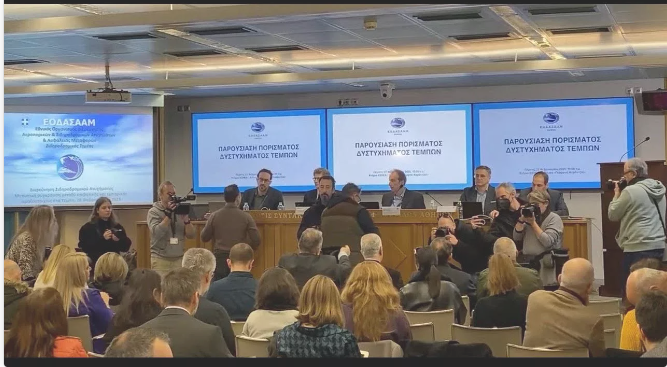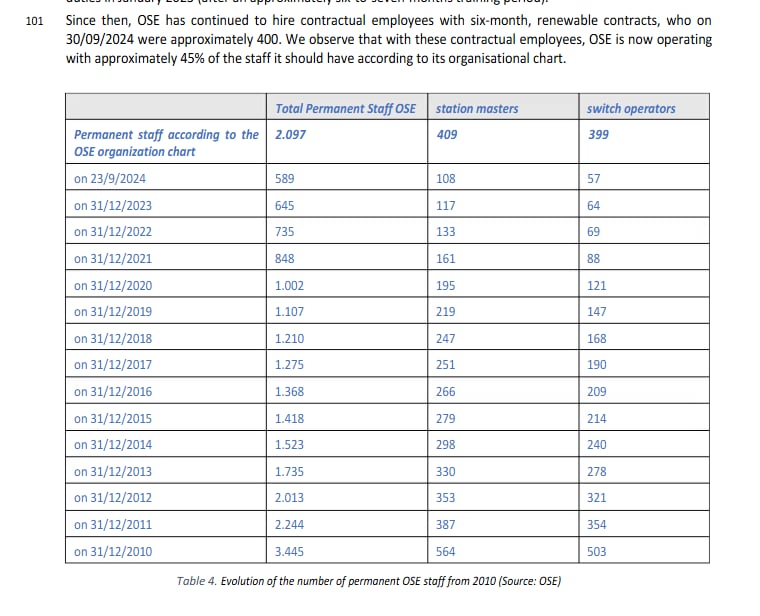Long-awaited report on Tempe case: Possible presence of unreported fuel, lost evidence, lack of railway safety, understaffing, underfunding

The findings of the independent Hellenic Aviation and Railway Safety Investigation Agency (EODASAAM) regarding the Tempe railway disaster were presented this morning.
“Our agency was supposed to have existed since 2004, but was established at the end of January 2023.”
President of the Railway Sector of EODASAAM Christos Papadimitriou stated:
“EODASAAM is the national body responsible for investigating aviation and railway accidents, which should have been established in Greece in 2004, as required by Directive 49. However, it did not exist until 2023, just a month before the accident, but it lacked leadership and investigators.”
“As a result, when the tragic accident occurred, which was due to a series of criminal mistakes and omissions over many years in Greece, there was no functioning body to investigate it.”
“The Agency’s findings are made with complete independence, and in its decision yesterday, the EODASAAM Council adopted the report without changing a single comma, as it should, in line with its independence.”
Papadimitriou also stressed that EODASAAM is not subject to interference by law or by the European institutional framework from anyone, including ministers or the prime minister.
“The fact that our Agency did not exist on the night of 28 February, 2023, as you will see in our report, created serious problems in the investigation and led to the loss of crucial evidence.”
“Contract 717 was never completed. The state’s decision to abandon the railway and the austerity measures which led to OSE being understaffed were decisive factors in the tragedy”
He added, “However, two other decisive factors contributed to this tragedy. First, the longstanding decision by the Greek state to abandon the railway by not investing the necessary funds, and second, the memorandums, which led to the depletion of OSE’s staff, which was crucial for safety. All of this, as will be highlighted in our report, contributed decisively to this tragedy.”
“lack of operational staff”
“5-7 victims survived the impact and died from the fire”
“possible presence of a hitherto unknown fuel”
Konstantinos Kapetanidis, Head of the Accident Investigation Unit of EODASAAM, discussed the abandonment of the railway network in the country. He specifically pointed out that while two workers are needed for every kilometre of track, in Greece, there were only 0.5 workers per kilometre, highlighting the staff shortage.
“While in Europe €170,000 is allocated per kilometre of track, in Greece, in 2020, only €20,000 was allocated,” he said.
As mentioned in the report, OSE repeatedly hired workers on six-months renewable contracts, and by 30/09/2024, there were approximately 400 such workers.
“With these cantractual workers, OSE operates with only 45% of the staff it should have, according to its organisational chart.”
As stated in the report, OSE (Hellenic Railways Organization) repeatedly hired workers on six-month contracts, which were renewed. By 30/09/2024, approximately 400 such workers were employed.
“with these contractual employees, OSE is now operating with approximately 45% of the staff it should have according to its organisational chart.”

He emphasised that, in addition to the complete lack of staff, the tracks were poorly maintained, and there was no preventive maintenance on the network. Furthermore, aside from the poor management of the stationmasters’ capabilities, who received their certifications from OSE, there was extreme overwork.
He stated:
“This resulted in the equipment used, demanded tasks, available work environment and overall organisational arrangements stretching the limits of the operational staff beyond what is humanly acceptable in a sustainable way.”
“A situation that was further reinforced by the way RAS focused on non-compliance in its investigations, analyses and recommend”
The report mentions that, by early 2023, as was the case a decade ago, Greece had no operational National Body for investigating incidents and accidents on the railway. The lack of independent investigations meant that lessons could not be learned from previous incidents, and this was further reinforced by the common belief that a functional and safe railway could be maintained merely by adhering to regulations, even if the supporting equipment or safety systems had not been installed.
Mr. Kapetanidis concluded that most of the victims died from mechanical causes.
“The rail vehicles are not designed to withstand collisions at speeds above 36 km/h,” he said.
“Obviously, measures could have been taken by OSE, such as reducing the speed limit. Instead, there was no regulation on speed adjustment in areas without signaling system. The trains were moving at 160 km/h whether there were signals or not.”
The EODASAAM report concludes that 5-7 victims of 57 died from the fire. Regarding the fire, he said:
“The fireball was enormous. We concluded that there was no indication that the railway material caused the fire. The presence of an unknown fuel is possible,” he added.
The report mentions that “traces of various hydrocarbons, including xylene, were found in a soil sample near the tracks.” However, it was noted that, in October 2023, two soil samples were taken from the exact same area, and there were no traces of xylene, concluding that “xylene is not typically found as a result of pollution or other natural causes. This confirms the abnormal presence of xylene in the first sample.“
As stated in another part of the report, “The observations, combined with simulations conducted, led Professor Konstantopoulos to the following conclusion: the large fireball in Tempe, which ignited 0.5 seconds after the train collision, could not have been caused by silicone oils, which, although flammable at high temperatures, cannot – due to kinetic reaction – ignite in the existing conditions. Additionally, the absence of white dust (silicon dioxide) at the accident site in quantities that would explain the ignition of a large amount of silicone oil is further evidence that this did not occur.
“These observations, together with the performed simulations, confirm the conclusion that was also made by Prof. Konstandopoulos : The large fireball at the Tempi railroad accident that occurred within 0.5 sec from the collision of the trains cannot be attributed to the transformers oil (PDMS) which although combustible at high enough temperatures (> 400) it could not – due to reaction kinetics reasons – ignite in the prevailing environment”
“Furthermore, the absence of white dust (Silicone dioxide, SiO₂) at the scene of the accident, in quantities that would justify the combustion of a large quantity of silicone oil, is another clear indication that such an occurrencedid not take place.”
“Hence the origin of the fireball consistent with a few tons of a flammable volatile fuel needs tobe searched elsewhere.”
In response to a question from Documento regarding the unknown fuel type, Head of Safety and Operations at European Union Railways and member of the EODASAAM, Bart Accou stated that they could not be certain about the chemical nature of the fuel. This is because the accident inspection was not conducted in the appropriate way to identify the fuel type.
“There have been estimates about what the fuel could be, but they remain estimates,” Accou added, clarifying that valuable evidence had been lost.
“The only conclusion we could reach is that the train’s engines or the officially recorded cargo cannot explain the fireball.”
“We lost crucial information”
Asterios Alexandrou, Head of the Railway Accidents Department of EODASAAM spoke next, mentioning the high risk of exacerbating post-traumatic stress disorder (PTSD) suffered by the survivors, “especially among those who did not have timely access to support. More than 25% of the sample we studied still suffers from severe PTSD.”
He also highlighted the lack of coordination at the operational level during the investigation and rescue efforts, noting that significant evidence had been lost, preventing the truth from being uncovered.
“There was no proper mapping of the accident site. We lost crucial information,” he said.
He added, “RAS did not identify critical weaknesses in safety. Several of them were later identified.”
Recommendations for OSE, Hellenic Train, RAS, and the European Union
He then outlined specific recommendations made by EODASAAM for OSE, Hellenic Train, RAS, and the European Union:
- OSE: Continue work on infrastructure and fix flaws, hire more engineers and staff to improve coordination and on-the-ground checks, and establish backup systems.
- Hellenic Train: Ensure proper maintenance and equipment.
- RAS: Conduct independent, rigorous investigations and support the national policy to strengthen railway safety measures and train service quality.
- EU: Conduct an in-depth review of safety regulations and active support for railways in crisis zones.
Read the timeline of the Tempe case here
The EODASAAM Report
______________________________________________
Are you seeking news from Greece presented from a progressive, non-mainstream perspective? Subscribe monthly or annually to support TPP International in delivering independent reporting in English. Don’t let Greek progressive voices fade.
Make sure to reference “TPP International” and your order number as the reason for payment.